 Now with QuickTime clips. Now with QuickTime clips.  |
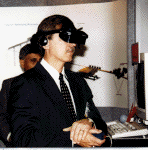
Step Inside the Cyberworld of a Virtual Reality
Steel Mill
Tammy M. Beazley
Figure 1. An undentified viewer takes a stroll through a hot strip mill via a virtual reality display. The mouse in his hand controls his movement within the mill. Images can also be seen by onlookers on the computer in the right of the photograph.
Attendees at the recent Iron and Steel Exposition in Pittsburgh, Pennsylvania,
had the opportunity to visit an operating hot strip mill without leaving the
Lawrence Convention Center simply by putting on a helmet. Like the winged
sandals of Hermes, the helmet transported its wearer to another place—into a
virtual world.
Viewers were able to don the helmet and interact in a virtual reality
presentation of a three-dimensional (3-D) animated steel mill (Figure 1). The
display was operated by Tippins Incorporated and featured the Tippins-Samsung Process (TSP[TM]) for thin-slab casting.
| QuickTime Clips from the Simulation |
|---|
| Plant Overview (~1,800K) | Traveling Slab (~1,500K) | Strip Rolling (~2,000K) |
|---|
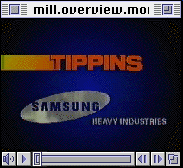 | 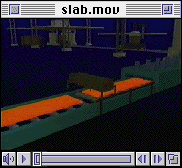 | 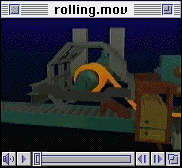 |
Exclusively prepared for JOM, these clips were extracted from a TSP promotional VHS videotape produced by Tippins. Click on an image to download the QuickTime file (8 frames per second, 24 bit color, Cinpak codic compression at 100% quality, 11 kHz audio). The clips were prepared by Joe Hager.
In the virtual world, a viewer observes the entire TSP process on a screen in
the helmet, beginning at the electric arc furnace melt shop (Figure 2). The
viewer watches as the steel is taken from the melt shop via a ladle and placed
in the tundish of the continous caster (Figure 3). [The continuous caster
viewed from above is reproduced on the this issue's cover—ed.] The slab
emerges from the caster (Figure 4) and is cut before proceeding to a slab
heating/equalizing furnace placed between the casting line and the rolling mill
line (Figure 5). After approximately 30 minutes in the furnace, the slab moves
along the line into the reversing rolling mill (Figure 6), where it is reversed
back and forth for a total of three flat roughing passes and six coiling
finishing passes. After rolling, the strip is cooled in a series of laminar
cooling banks as it reaches the coiler, the final step in the conversion
process (Figure 7).
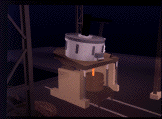 Figure 2. A 3-D image of an electric arc furnace melt shop.
Figure 2. A 3-D image of an electric arc furnace melt shop.
There is no starting or ending point in the display; the viewer controls his
or her own movement within the model. Viewers move forward in the display by
using the computer's mouse; to see to the left or right, up or down, the
individual simply moves his or her head. Sounds become increasingly louder as
the viewer walks toward objects, and the images come more into focus as the
viewer gets closer to them. While the viewer experiences the mill through the
helmet, onlookers can see what the viewer sees by watching the images on an
accompanying computer.
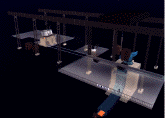 Figure 3. The animated computer image of the electric arc furnace melt shop and the continuous caster.
Figure 3. The animated computer image of the electric arc furnace melt shop and the continuous caster.
Originally a 3-D animated video, the virtual reality display was made for
Tippins by Jerry O'Connor of Summit Graphics in Pittsburgh, Pennsylvania.
Unlike virtual reality games, which attempt to immerse the viewer inside the
program, the Tippins display was more of a tool to enhance understanding of a
process, said O'Connor.
"We created the video intially to introduce the TSP process to customers. This
was just another step," said Maggie Cessar, marketing manager for Tippins.
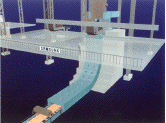 Figure 4. Steel slabs emerge from the caster to be cut in virtual reality modeling.
Figure 4. Steel slabs emerge from the caster to be cut in virtual reality modeling.
O'Connor worked with engineers and draftsmen at Tippins to develop the
computer-drawn, 3-D mill for video in 1994. To create the mill, O'Connor
started with drawings (e.g., floor plans, photographs, etc.) submitted by
Tippins. By using a computer-aided design program, the 3-D buildings were
developed with accurate heights and thicknesses. Next, color, textures, and
shadow lighting were incorporated using 3-D Studios, an animation
application. Sounds were incorporated from videotapes made at several different
mills.
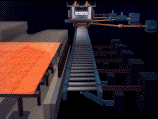 Figure 5. After cutting, the slab travels into the slab equalizing furnace in the model.
Figure 5. After cutting, the slab travels into the slab equalizing furnace in the model.
The animation came next. In order to create a working mill, O'Connor
calculated a path of activity that was then converted into an animated model by
the 3-D Studio application. It takes approximately ten minutes for the
computer to create a single frame; when completed, the video shows 30 frames
per second.
The virtual reality display was made from the 3-D video. Unlike the video,
pictures in virtual reality are created in real time as the viewer interacts
with the application. In order to make the display work effectively, O'Connor
simplified the model so that the display shows ten pictures every second. Work
began in June, and the display was completed in August; final revisions and
details were added in September just before the display's introduction at the
convention. The total cost of the interactive display was approximately
$25,000.
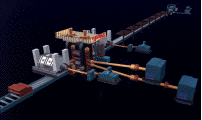 Figure 6. A 3-D image of a reversing rolling mill.
Figure 6. A 3-D image of a reversing rolling mill.
"We've had a tremendous response," said Cessar. "People are amused by it. It
makes a little bit of excitement for the technology." In fact, the display was
so popular that Tom Murphy, the mayor of Pittsburgh and the son of a
steelworker, visited the booth.
Although virtual reality displays are frequently seen at computer trade
shows, Tippins is the first to incorporate it into the steel manufacturing
industry, said Cessar. The virtual reality display was done specifically for
the convention, and its performance will be reviewed to determine if the
display is used for future sales presentations. Because the display requires so
much equipment to operate it, Tippins may use it only for trade shows such as
the Iron and Steel Exposition; however, the 3-D video is still used in sales
presentations.
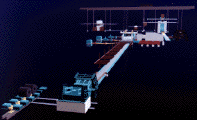 Figure 7. The coiler is the final step in the virtual reality display.
Figure 7. The coiler is the final step in the virtual reality display.
As the role of computers in the production of steel expands, it seems only fitting that computers assist in the commercial aspects as well. The popularity of this display, evidenced by the fact that the headset was hardly ever idle at the show, is a good indicator of the industry's willingness to accept this new marketing tool. More opportunities will arise to display processes and technological products via virtual reality—the next best thing to being there.
Tammy M. Beazley is a staff writer for JOM.
Copyright held by The Minerals, Metals & Materials Society, 1995
Direct questions about this or any other JOM page to jom@tms.org.






 Figure 2. A 3-D image of an electric arc furnace melt shop.
Figure 2. A 3-D image of an electric arc furnace melt shop.
 Figure 3. The animated computer image of the electric arc furnace melt shop and the continuous caster.
Figure 3. The animated computer image of the electric arc furnace melt shop and the continuous caster.
 Figure 4. Steel slabs emerge from the caster to be cut in virtual reality modeling.
Figure 4. Steel slabs emerge from the caster to be cut in virtual reality modeling.
 Figure 5. After cutting, the slab travels into the slab equalizing furnace in the model.
Figure 5. After cutting, the slab travels into the slab equalizing furnace in the model.
 Figure 6. A 3-D image of a reversing rolling mill.
Figure 6. A 3-D image of a reversing rolling mill.
 Figure 7. The coiler is the final step in the virtual reality display.
Figure 7. The coiler is the final step in the virtual reality display.